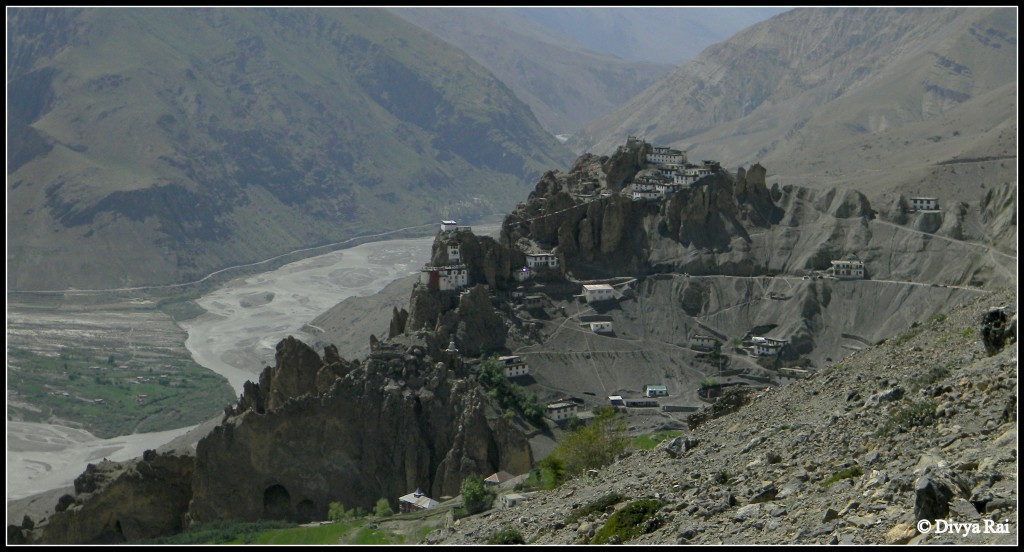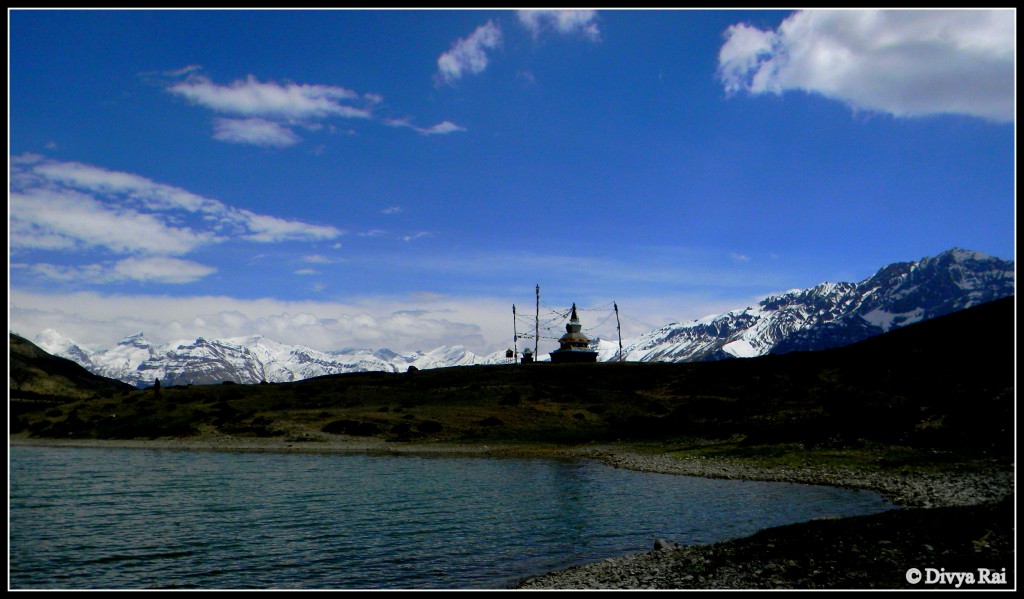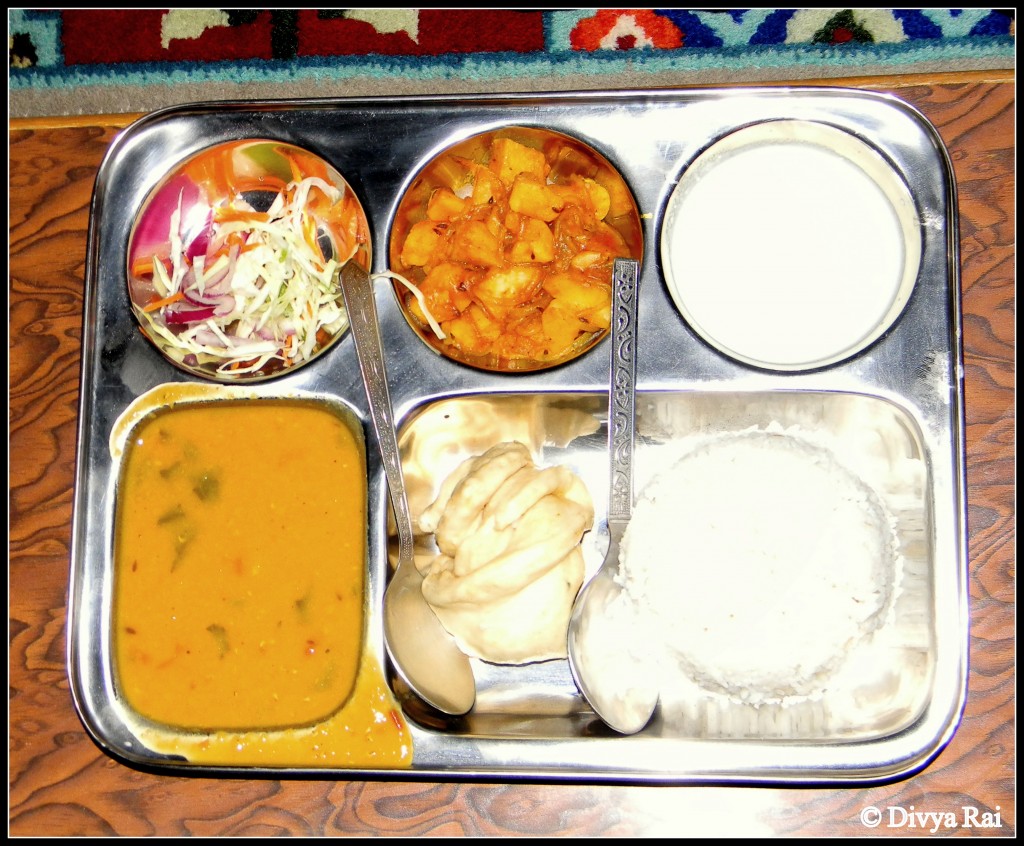Read Day 1 here. We traveled from Kaza to Tabo, and went for the Dhankar hike on this day.
The next morning, we got up at 6:00 am. It was bright, sunny, and clear as compared to what we usually experience in Delhi or any other metro city in India.
Kaza has a kind of stillness you crave back home.
This town did not wake up to cars honking their horns or vendors calling out to sell their wares.
It did not wake up to traffic jams and rushed mornings.
It woke up just the way a sleepy town does.
The mornings here definitely sound different from an extremely urbanized city. I refrain from using the word civilized/civilization, as to me, even the most tribal communities have their civilization. We choose to refer to them as tribal/traditional just because it is a world that is beyond our comprehension and comfort zone.
After our morning tea, it was time for us to get ready. We realized that there was no hot water for bathing. (No electricity = no geyser)
(Update: I am told that some places now use solar geysers and have a continuous supply of hot water).
We requested the kitchen to facilitate us with stove-heated water, which they happily obliged us with. I had a conversation with myself and reasoned that it made sense to stick to the naturally available means so that the body becomes accustomed to the changes without much problem. I bathed with running tap water, which was fairly cold.
The Plan For The Day
For the day, along with a visit to the Dhankar monastery, we had a hike to the Dhankar lake in our itinerary. We were to spend the night at Tabo, which is in a gradual decline from Kaza.
We started from Kaza at about 9:00 am and it took us 1 hour 45 mins to reach the Dhankar new monastery.
Dhankar is a cliff village, at the height of 12447 ft above sea level.

Villages in Spiti Valley
Is Sunscreen Required In Spiti Valley
It was a sunny day. The sun in Spiti tends to feel a bit more intense than it does in the plains. So the SPF 70 Sunscreen becomes your best friend. And no, it is not a cosmetic luxury. It is more of a necessity as some of us had our skin peeling off despite the precautions.
Dhankar Hike
The plan was to start our hike from the Dhankar new monastery (where our vehicle was parked) to Dhankar Lake. Dhankar’s New Monastery is at a distance of 2.5 km from Dhankar Lake.
We began our Dhankar hike at about 11:00 am.
Our guide, Anjaan, estimated that it should take us about forty minutes one way and approximately two hours for the entire hike (including the photo breaks).
Armed with that information, we started our Dhankar Hike. The first 450 meters of the Dhankar hike are extremely steep and require a good fitness level for one to go ahead. I noticed that trekking sticks make the whole experience a lot easier.
If you plan to buy one, buy these, as they are foldable and consume less space while packing.
For treks, more than physical fitness, you need mental fitness as it tests your willpower at various levels.
On our way up, we divided our group into three sub-groups and it, on average took us one and a half hours to reach the lake! My only curiosity and the reason for doing this hike was – I wanted to see that how a lake is wedged atop such steep hills and is surrounded by even steeper hills all around. Most of the path leading up to the lake is barely a foot-wide edge on the mountain slopes.
Dhankar Lake
Once you reach Dhankar Lake, you feel various emotions in one go. My first one was a disappointment. It looked like any other regular water body, quite unlike what I had imagined it to be. The surrealism bit sinks in gradually— you realize that the rocky mountains all around and the snow-capped Himalayas in the backdrop add to the beauty. As you sit and let the surroundings and the landscape sink in, you gradually see the beauty it has to offer. Dhankar Hike is worth it for the serenity alone.

Dhankar Lake in Spiti
Our guide suggested that we go around the circumference of the lake to enjoy the various perspectives it had.
It was a hot day and the uphill hike had made it a bit too uncomfortable for me.
Swimming In The Dhankar Lake…
I decided to take a dip in the lake to counter the effects of the blazing sun.
The minute I stepped into the water, my soul escaped my body for some good 10 seconds. The water was f-r-e-e-z-i-n-g cold. I realized that the icy-cold breeze from the snow-capped Himalayas was making it a lot colder. But once you swim a bit, you feel fairly warmed up. Or you can say when you are neck-deep in cold water, the icy-cold breeze stops being a problem. There are other problems like the slushy bottom of the lake or just staying afloat without touching the bottom at all.
Swimming in a lake is very different from swimming in a pool. The depth is often uneven and unpredictable and hence you should chart your course as per your level of expertise and stamina. Our guide, of course, was on tenterhooks because of my impromptu decision to swim in this lake.
My other travel-mates (except the one I had requested to stay back with me, just in case some emergency cropped up) had strolled to the other side of the lake to click pictures of the landscape. Soon, they wrapped up their photo session and we joined them to head back to the Dhankar new monastery.
From Dhankar Lake to Dhankar Monastery
The way back was effortless until the last 450 meters, after which, it was a bit exerting on the knees. It also offered amazing perspectives for photography all along.
The mountains (both the rocky ones and the snow-covered ones), the meandering river, the Dhankar cliff village, and the fields where the village dwellers grew their cash crops are factors so poles apart from each other, and the fact that they existed in one frame added to the surrealism. It took us one hour from Dhankar Lake to Dhankar’s new monastery. The time frame includes the photo breaks that we took in between.
The good thing about the hike was that despite being cautioned that Dhankar is a medium-level hike, all of us attempted and completed it.
The Canteen At Dhankar New Monastery
We took our lunch break at the Dhankar new monastery’s canteen. Maanik, a friendly chap, ran the place. Dhankar, like the entire Spiti valley, had no electricity, and hence shakes, pizzas and other things were out of the question. While of course, we were not there to have shakes and pizzas, and here it might look like just two things out of the menu, in reality, a lot of dishes were ruled out.
The valley was cut off from the cities (Shimla and Manali) where it gets its ration and refill from, for quite a while post the natural calamity (in Uttarkashi 10 days ago in June 2013), and it waited for the supplies to resume. So the only option was chai, daal-rice, momos, and thukpa. The majority of us had thukpa. It was a very bland version of what we in the plains are used to, but we quite liked it. I guess that is what a 5 km hike does to you.

Thukpa in Spiti Valley
Strolling Around: Dhankar New Monastery
After the lunch break, the plan was to go to the Dhankar Old Monastery, which was on a slight uphill trek. I, along with two other travel-mates decided to skip it as we had various levels of dehydration and fatigue. The other six, along with our guide Anjaan, visited it.
Meanwhile, I decided to take a walk around the new monastery. There was a place where they had put several devices for charging with solar power, for usage post-sun-down. It made me think about the fact that the level of discipline this (electricity or the lack of it) calls for. You charge all the gadgets at one time to survive and make do at other times.
Meanwhile, the group took an hour and a half to be back from the old monastery trek. At around 5:30 pm,, we started from Dhankar’s new monastery to Tabo.
The landscape till Dhankar is quite barren and desert-like. It is only when you hit Tabo that you see a bit of greenery around you.
Tabo Village: Our Night Halt
We reached Tabo at around 6:45 pm.
Tabo is located at a height of 10065 ft.
Almost 60% of the population in Spiti is either named Tsering (pronounced as ‘sherring’) or Sonam. If you call out to no Sonam in particular, there are high chances that you might be addressing an entire village in one go.
About Homestays In Spiti
A word about the homestays in Spiti; the place we stayed at was a proper guest house with 5 huge amazing rooms. But a lot of places that are guesthouses write ‘home-stay’ in their establishment name. The reason for this is that the homestays in Spiti stand to get some tax rebates and other benefits. I got to know that after the government made this rule, it further appended it to ‘any place with more than 4 rooms up for bookings does not qualify to be a homestay, and it is a guesthouse’.
This ensured that there was no misuse of the scheme, and only the ones who needed those benefits the most got them.
Tabo is a town with a population of approximately 400 people.
Sonam Guest House, Tabo
Sonam Homestay was the guesthouse we stayed at.
We reached the guest house and the amazing Mr.Sonam allotted us our rooms. Why I call him amazing shall unfold later. I had a corner room on the first floor, called Dhankar. We collected our luggage and put it in our respective rooms and assembled in the common area for our evening tea. We decided that we would have Spitian Thali for dinner at 9:00 pm. Post-tea, we still had 2 hours at hand. Most of us decided to take rest or freshen up.
Strolling Around In Tabo
My camera batteries had given up and I needed to charge them. Tabo too, like the rest of the Spiti, did not have electricity and was making do with Solar lamps and power. The village cyber-cafe had solar power back up and I decided to request them to charge my camera batteries at a cost if need be. They allowed me to charge the batteries and did not charge me for it (pun unintended). I decided to use the internet to make up for the effort he took to make things easier for me.
45 minutes later, the batteries were fully charged, so I paid for the internet usage and left for the guest house. I also wanted to call up my family and tell them that all was good and under control but the authorities were still in the process of restoring the landline connection in the valley.
During The Walk Back To The Guest-House In Tabo…
As I was leaving the cybercafe, the owner’s wife offered to accompany me on the walk back to my guesthouse. It was the cloudy moonlit sky in the otherwise total pitch dark night. Spiti Valley is a safe region, so much so, that it can easily be said to be a 100% crime-free zone. That is the reason that the lady’s request to accompany me back to the guest house took me by surprise. But I did not decline the offer, for I felt she knew better.
I came back to the guesthouse at around 8:30 pm and went to my room, freshened up, and joined everyone else in the dining room.
The dining room was lit with 4 solar lamps. In most of the Spiti homestays and guesthouses, the dining room has the traditional setup. You sit in the way you would sit on the floor and they serve the food on a slightly elevated narrow table that runs almost along the entire perimeter (three sides) of the room.
Spitian Thali in Tabo
For dinner, we had the amazing Spitian thali. I found the Spitian bread to be a work of art. It was a conch-shaped bread and they make it fresh, unlike the commercially available bread in the plains in India. It was something like the Ladakhi bread called Tingmo/timong, and is a kind of steamed bread.
The thaali also had daal, steamed rice, potato-glass noodles subzee, salad, and curd. I have taken a picture of our thaali. This is what I could manage with my P&S camera in almost total darkness.

Spitian thali
Spitian Culture And Its Conservation
Post dinner, Sonam joined us for a tete-a-tete. He played the guitar for us and sang a few Bollywood numbers and a local song. Sonam is dedicated to music and is active in preserving the cultural music of Spiti. He told us that there is a music school in Tabo that has a teacher (one of the village seniors) who is the only one left to know the traditional Spitian cultural music. The village people have facilitated the old gentleman to teach the art to the new generation so that the tradition does not die with him.
Sonam is actively involved in the development of the village and the conservation of culture in general. It surprised me how he managed time for such pursuits while running a guesthouse and manning its kitchen almost himself.
Goodnight!
After a bit, we all retired to our respective rooms. The trek had those body parts hurting, which we didn’t know existed. All I needed was a bed. I had a fever too, probably because of the swim in the cold water. I slept at 10:15 pm or so but got up in the middle of the night to take an antibiotic and paracetamol. Also, I was a bit worried about my fever as the next day was scheduled to start at 9:00 am.
What to pack for a day like this:
1) Trekking sticks
2) Raincoat. Poncho-style ones are the best; they cover the backpack as well.
3) Snacks
4) Pain relief cream; I use Volini.
5) Torch; this one is much more value for money than the one I bought for myself at Rs.800 as a last-minute purchase.
Read Day 3 here.
P.S.:
Metrics:
Distance between Kaza and Dhankar: 24 km
Also, the distance between Dhankar and Tabo: 23kms
Distance between Kaza and Tabo: 48kms
And, the Dhankar Hike Distance: 5kms up and down





No Responses